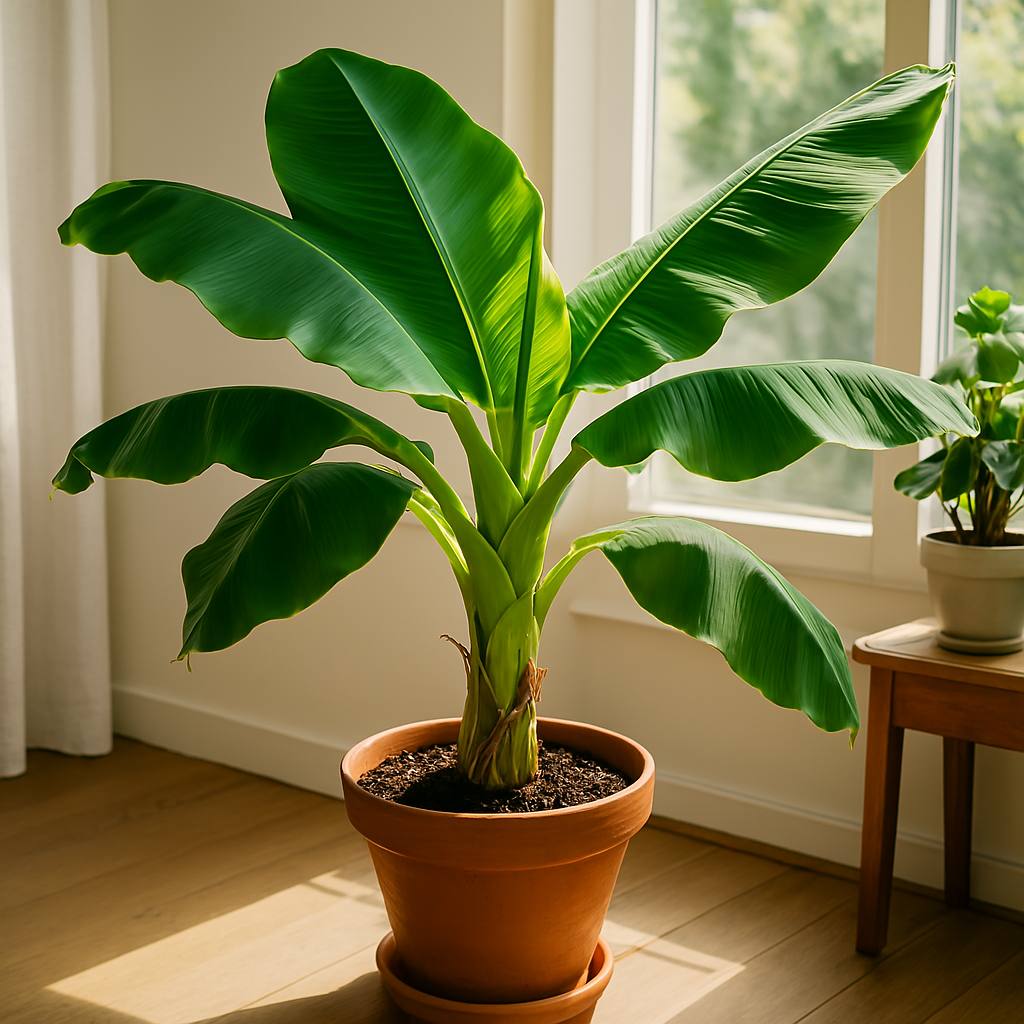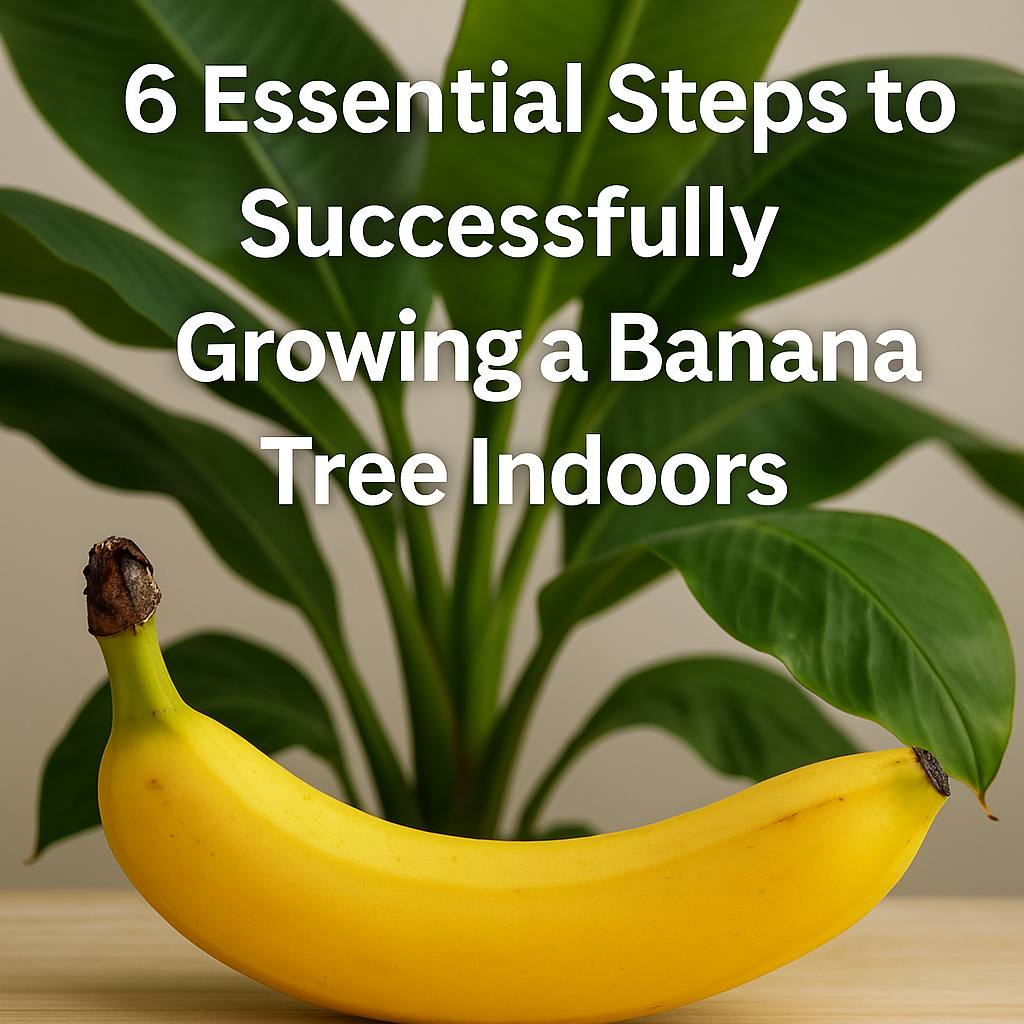Growing a banana tree indoors may seem like a challenge, but with the right care, you can enjoy a lush, tropical plant in your home. 6 Essential Steps to Successfully Growing a Banana Tree Indoors will guide you through the key techniques to ensure healthy growth, from choosing the right variety to maintaining optimal conditions. Whether you want to grow it for its ornamental beauty or even for fruit production, this guide will help you every step of the way.
⸻
Contents
- 1 1. Choose the Right Banana Variety
- 2 2. Provide Plenty of Light
- 3 3. Use Well-Draining Soil and a Large Pot
- 4 4. Maintain Proper Temperature and Humidity
- 5 5. Water and Fertilize Correctly
- 6 6. Prune and Repot for Continuous Growth
- 7 Common Indoor Banana Tree Problems & Solutions
- 8 FAQ: Growing a Banana Tree Indoors
- 8.1 Can you really grow a banana tree indoors?
- 8.2 How much light does an indoor banana tree need?
- 8.3 What type of soil is best for banana trees?
- 8.4 How often should I water my banana tree?
- 8.5 Do banana trees need humidity indoors?
- 8.6 How long does it take for an indoor banana tree to produce fruit?
- 8.7 What temperature is best for indoor banana trees?
- 8.8 Do banana trees need fertilizer?
1. Choose the Right Banana Variety
Not all banana trees are suitable for indoor growth. Standard banana plants can grow over 15 feet tall, making them impractical for most indoor spaces. Instead, opt for dwarf varieties that thrive in pots while still producing broad, lush leaves.
Best Indoor Banana Tree Varieties:
• Dwarf Cavendish – A popular choice for indoor gardeners, this variety stays compact and can produce fruit under the right conditions.
• Super Dwarf Banana – Even smaller than the Dwarf Cavendish, it’s an excellent option for limited spaces.
• Dwarf Red Banana – A visually striking plant with red-tinted leaves that adds a decorative touch to any room.
💡 Pro Tip: Opt for tissue-cultured banana plants, as they are disease-free and adapt well to indoor conditions.
⸻
2. Provide Plenty of Light
Banana trees require at least 6-8 hours of bright, indirect sunlight daily. Without sufficient light, the leaves will become weak, and growth will slow.
Best Lighting Solutions:
• Place your plant near a south- or west-facing window for maximum sunlight exposure.
• If natural light is limited, use a full-spectrum grow light for at least 12-14 hours per day during fall and winter.
Common Mistake to Avoid: Avoid placing your banana tree in direct, intense sunlight without acclimating it first—this can cause leaf scorch.
⸻
3. Use Well-Draining Soil and a Large Pot
Banana trees are fast growers with extensive root systems, so they need nutrient-rich, well-draining soil and a spacious container to accommodate their growth.
Potting Tips:
• Choose a large container (at least 15-20 gallons) with good drainage.
• Use a soil mix containing potting soil, sand, perlite, and compost for aeration and moisture retention.
• A slightly acidic to neutral pH (5.5-7.0) is ideal for optimal nutrient absorption.
💡 Pro Tip: To improve drainage, place a layer of pebbles or broken terracotta pieces at the bottom of the pot before adding soil.
⸻
4. Maintain Proper Temperature and Humidity
Banana trees thrive in warm, humid environments that mimic their tropical origins. For successful indoor growth, keep the temperature between 75-85°F (24-29°C) and maintain humidity levels of 50-70%.
🔥 Indoor Climate Hacks:
• Use a humidifier or a humidity tray (a shallow dish filled with water and pebbles) to prevent dry air from damaging the leaves.
• Avoid placing your plant near cold drafts, heaters, or air conditioners, which can cause stress.
• If your indoor air is dry, mist the leaves occasionally to prevent browning edges.
🌡️ Winter Care Tip: If temperatures drop below 60°F (16°C), the banana tree may enter dormancy, slowing its growth. Reduce watering and keep it away from cold windows.

⸻
5. Water and Fertilize Correctly
Banana trees love moisture but hate soggy roots. Overwatering can lead to root rot, while underwatering can cause the leaves to dry out and curl.
Watering Routine:
• Water deeply when the top inch of soil feels dry (usually 2-3 times per week in warm months, less in winter).
• Use lukewarm water to prevent shocking the roots.
• Ensure excess water drains freely to avoid root rot.
🌿 Feeding Routine:
• Apply a balanced liquid fertilizer every 2-4 weeks during the growing season.
• Supplement with organic nutrients like compost tea, banana peels, or worm castings for natural enrichment.
• In fall and winter, reduce feeding to once a month as growth slows down.
🍌 Pro Tip: High-potassium fertilizers (such as those labeled 10-10-10 or 20-20-20) promote strong growth and encourage fruiting.
⸻
6. Prune and Repot for Continuous Growth
To keep your indoor banana tree healthy and manageable, regular pruning and occasional repotting are necessary.
✂️ Pruning Guide:
• Remove yellowing or dead leaves to improve air circulation and reduce disease risk.
• Trim excess suckers (small offshoots) to direct energy into the main stalk.
🌱 Repotting Tips:
• Repot every 1-2 years or when roots start circling inside the container.
• Choose a new pot at least 2 inches larger in diameter to allow for continued growth.
• Gently loosen the root ball before transplanting to encourage root expansion.
⸻
Common Indoor Banana Tree Problems & Solutions
❌ Leaves Turning Brown? → Increase humidity with misting or a humidifier.
❌ Drooping Leaves? → Ensure the plant isn’t overwatered and check for proper drainage.
❌ Slow Growth? → Move the plant to a sunnier spot or supplement with grow lights.
❌ Pests Like Spider Mites or Aphids? → Wipe leaves with neem oil or insecticidal soap.
⸻
Final Thoughts
With 6 Essential Steps to Successfully Growing a Banana Tree Indoors, you can enjoy a vibrant and tropical plant inside your home. While fruit production indoors is rare, these steps will ensure a healthy and thriving banana tree that adds beauty to your indoor space.
🌿 Want expert gardening advice? Visit Furney’s Nursery for premium indoor plant care tips and supplies!
Learn more about 7 Powerful Steps to Growing Romanesco Broccoli
FAQ: Growing a Banana Tree Indoors
Can you really grow a banana tree indoors?
Yes! Dwarf banana varieties like Musa ‘Dwarf Cavendish’ thrive indoors with proper care.
How much light does an indoor banana tree need?
Banana trees require at least 6–8 hours of bright, direct sunlight daily. A grow light can supplement natural light.
What type of soil is best for banana trees?
Use well-draining, nutrient-rich soil with a mix of peat, perlite, and compost for optimal growth.
How often should I water my banana tree?
Keep the soil moist but not soggy by watering when the top inch of soil feels dry.
Do banana trees need humidity indoors?
Yes! Maintain humidity levels around 50–60% by misting the leaves or using a humidifier.
How long does it take for an indoor banana tree to produce fruit?
With proper care, dwarf banana trees can produce fruit in 12–24 months.
What temperature is best for indoor banana trees?
They thrive in 75–85°F (24–29°C) during the day and should not be exposed to temperatures below 60°F (15°C).
Do banana trees need fertilizer?
Yes, feed with a balanced fertilizer (10-10-10 or 20-20-20) every 2–4 weeks during the growing season.
A garden is a place that relaxes us and reflects our personal style, it’s a place to spend time with loved ones and grow our own fruits and vegetables. Maybe you’re looking for design inspiration or plant selection, or you’re concerned about garden privacy, shady areas, or pests, but don’t worry, you’ve come to the right place.
